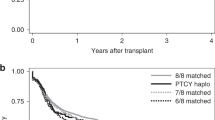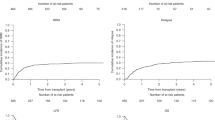Abstract
A mismatch at HLA-DPB1 locus is associated with higher acute GVHD and lower relapse rate after myeloablative (MAC) allogeneic hematopoietic cell transplantation (alloHCT). Also, in MAC setting, mismatch permissiveness and expression level impact alloHCT outcomes. However, in reduced intensity conditioning (RIC), DP mismatch effect on transplant outcomes is unknown. We retrospectively evaluated DP mismatch influence (number, permissiveness, and expression) on HCT outcomes in 310 patients with high-resolution typing (HLA-A, -B, -C, -DRB1, -DQB1, and -DPB1), who underwent RIC HCT. By multivariable analysis, 11/12 had better overall survival (OS) and relapse vs. 12/12 (HR = 1.61 and 2.02; p = 0.04 and 0.01, respectively) and better OS vs. 10/12 (HR = 1.68; p = 0.02). Within the 11/12, nonpermissive (NoPR) mismatch was associated with higher risk of grade II–IV acute GVHD (HR = 1.97; p = 0.005) and nonrelapse mortality (HR = 2.13; p = 0.02) vs. permissive (PR). Grouping 11/12 based on the DP expression conferred higher mortality (HR = 3.78; p = 0.003) when low expressers received a graft from high expressers (AG) vs. low expressers (AA). Better OS was achieved in PR 11/12, when expression was low in patient and donor (AA) vs. all other combinations. Therefore, in RIC HCT, a single-DP mismatch has a protective role, especially in permissive setting, when donor and recipient are low expressers.
This is a preview of subscription content, access via your institution
Access options
Subscribe to this journal
Receive 12 print issues and online access
$259.00 per year
only $21.58 per issue
Buy this article
- Purchase on Springer Link
- Instant access to full article PDF
Prices may be subject to local taxes which are calculated during checkout



Similar content being viewed by others
References
Farhadfar N, Hogan WJ. Overview of the progress on haploidentical hematopoietic transplantation. World J Transplant. 2016;6:665–74. https://doi.org/10.5500/wjt.v6.i4.665.
Fabricius WA, Ramanathan M. Review on haploidentical hematopoietic cell transplantation in patients with hematologic malignancies. Adv Hematol. 2016;2016:5726132. https://doi.org/10.1155/2016/5726132.
Choo SY. The HLA system: genetics, immunology, clinical testing, and clinical implications. Yonsei Med J. 2007;48:11–23. https://doi.org/10.3349/ymj.2007.48.1.11.
Pidala J, Lee SJ, Ahn KW, Spellman S, Wang HL, Aljurf M, et al. Nonpermissive HLA-DPB1 mismatch increases mortality after myeloablative unrelated allogeneic hematopoietic cell transplantation. Blood. 2014;124:2596–606. https://doi.org/10.1182/blood-2014-05-576041.
Shaw BE, Gooley TA, Malkki M, Madrigal JA, Begovich AB, Horowitz MM, et al. The importance of HLA-DPB1 in unrelated donor hematopoietic cell transplantation. Blood. 2007;110:4560–6. https://doi.org/10.1182/blood-2007-06-095265.
Lee SJ, Klein J, Haagenson M, Baxter-Lowe LA, Confer DL, Eapen M, et al. High-resolution donor-recipient HLA matching contributes to the success of unrelated donor marrow transplantation. Blood. 2007;110:4576–83. https://doi.org/10.1182/blood-2007-06-097386.
Thomas R, Thio CL, Apps R, Qi Y, Gao X, Marti D, et al. A novel variant marking HLA-DP expression levels predicts recovery from hepatitis B virus infection. J Virol. 2012;86:6979–85. https://doi.org/10.1128/jvi.00406-12.
Petersdorf EW, Malkki M, O’HUigin C, Carrington M, Gooley T, Haagenson MD, et al. High HLA-DP expression and graft-versus-host disease. New Engl J Med. 2015;373:599–609. https://doi.org/10.1056/NEJMoa1500140.
Morishima S, Shiina T, Suzuki S, Ogawa S, Sato-Otsubo A, Kashiwase K, et al. Evolutionary basis of HLA-DPB1 alleles affects acute GVHD in unrelated donor stem cell transplantation. Blood. 2018;131:808–17. https://doi.org/10.1182/blood-2017-08-801449.
Fleischhauer K, Shaw BE, Gooley T, Malkki M, Bardy P, Bignon JD, et al. Effect of T-cell-epitope matching at HLA-DPB1 in recipients of unrelated-donor haemopoietic-cell transplantation: a retrospective study. Lancet Oncol. 2012;13:366–74. https://doi.org/10.1016/S1470-2045(12)70004-9.
Fleischhauer K. Immunogenetics of HLA-DP-A new view of permissible mismatches. New Engl J Med. 2015;373:669–72. https://doi.org/10.1056/NEJMe1505539.
Crivello P, Zito L, Sizzano F, Zino E, Maiers M, Mulder A, et al. The impact of amino acid variability on alloreactivity defines a functional distance predictive of permissive HLA-DPB1 mismatches in hematopoietic stem cell transplantation. Biol Blood Marrow Transpl. 2015;21:233–41. https://doi.org/10.1016/j.bbmt.2014.10.017.
Robinson J, Halliwell JA, Hayhurst JD, Flicek P, Parham P, Marsh SG. The IPD and IMGT/HLA database: allele variant databases. Nucleic acids Res. 2015;43 database issue:D423–31. https://doi.org/10.1093/nar/gku1161.
Schone B, Bergmann S, Lang K, Wagner I, Schmidt AH, Petersdorf EW, et al. Predicting an HLA-DPB1 expression marker based on standard DPB1 genotyping: linkage analysis of over 32,000 samples. Hum Immunol. 2018;79:20–27. https://doi.org/10.1016/j.humimm.2017.11.001.
Fine JP, Gray RJ. A proportional hazards model for the subdistribution of a competing risk. J Am Stat Assoc. 1999;94:496–509. https://doi.org/10.1080/01621459.1999.10474144.
Glucksberg H, Storb R, Fefer A, Buckner CD, Neiman PE, Clift RA, et al. Clinical manifestations of graft-versus-host disease in human recipients of marrow from HL-A-matched sibling donors. Transplantation. 1974;18:295–304.
Shulman HM, Sullivan KM, Weiden PL, McDonald GB, Striker GE, Sale GE, et al. Chronic graft-versus-host syndrome in man. A long-term clinicopathologic study of 20 Seattle patients. Am J Med. 1980;69:204–17.
Acknowledgements
The authors would like to thank Dr Joycelynne Palmer for assistance with biostatistical data analysis and reviewing this manuscript. This study was partially funded by NIH P30 CA033572 (Biostatistics Core).
Authors Contribution
MMAM and KG designed and performed the research, analyzed the results, and wrote the manuscript. TS performed the biostatistical analysis and assisted with the writing. SM wrote the manuscript. CK, PP, DS, SJF, and RN contributed to the design of the experiments and assisted with the writing. AN helped with the study design and supervised the research, data analysis, and manuscript writing.
Author information
Authors and Affiliations
Corresponding author
Ethics declarations
Conflict of interest
The authors declare that they have no conflict of interest.
Additional information
Publisher’s note Springer Nature remains neutral with regard to jurisdictional claims in published maps and institutional affiliations.
Rights and permissions
About this article
Cite this article
Malki, M.M.A., Gendzekhadze, K., Stiller, T. et al. Protective effect of HLA-DPB1 mismatch remains valid in reduced-intensity conditioning unrelated donor hematopoietic cell transplantation. Bone Marrow Transplant 55, 409–418 (2020). https://doi.org/10.1038/s41409-019-0694-y
Received:
Revised:
Accepted:
Published:
Issue Date:
DOI: https://doi.org/10.1038/s41409-019-0694-y



